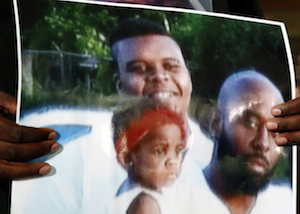FERGUSON, Mo. -- The unrest in Ferguson began one week ago, on the quiet side street of Canfield Drive, when residents were startled by a series of gunshots and poured out of their homes. They watched and wept as the police stood guard for hours over the body of 18-year-old Michael Brown, splayed facedown in the street.
RELATED ARTICLE
http://www.arkansas…">Curfew imposed after looting
What began in the streets has stayed there.
The generally calm, spontaneous protests by the people of Ferguson, furious about what they call systemic abuse of black people by the police, has intensified and, at times, turned violent, as crowds of people, mostly young men, spill onto West Florissant Avenue -- the city's commercial thoroughfare -- night after night.
Despite the demonstrators' persistence, the protest movement lacks direction and unified leadership. It has attracted disparate groups, some from within Ferguson, and some from hundreds of miles away. Walking through the crowds of demonstrators as they gather each evening, it is not unusual to see some people carrying handguns while only a block away parents push their toddlers in strollers.
Many demonstrators say they have shrugged off guidance from leaders in the black community and even the Brown family, which has repeatedly pleaded for calm.
For many people in Ferguson, who have seen their town gripped by fury and despair for a week, the protests seem not only leaderless and chaotic, but also as having no end in sight.
One protester, DeVone Cruesoe of the St. Louis area, said this week as he stood on Canfield Drive: "Do we have a leader? No." Pointing to the spot where Brown was killed, he said, "You want to know who our leader is? Mike Brown."
Early Saturday during a four-hour standoff with the police, some demonstrators, including Antonio French, a St. Louis alderman, spoke with the authorities and helped ease tensions.
As demonstrators crowded a key thoroughfare in Ferguson, some protesters grabbed megaphones to offer suggestions and calls for action. Still others tried to hold back protesters who seemed eager for a more serious clash with the authorities. And a group of demonstrators stood near an intersection to keep vehicles from driving too close to the police.
But at other moments, there were fewer signs of organization. As some protesters looted stores, for instance, there did not seem to be a plan for guarding other retailers. And as the night dragged on, many demonstrators took it upon themselves to try to set limits for others, pushing people away from possible targets for looting and assisting journalists accused of working for the police.
The Rev. Jesse Jackson arrived at the protest Friday night.
"People were so warm," he said. "It was that kind of celebration."
But he said Saturday morning that the violent tone of the protest reflected anger over police tactics. Ferguson, he said, is "a metaphor for urban America," where many members of minority groups and poor whites lack access to jobs, transportation and health care.
Many black civic leaders in St. Louis said they were frustrated by their inability to guide the protesters.
At an emotional meeting in a church Thursday, clergy members despaired over the seemingly uncontrollable nature of the protest movement and the flare-ups of violence that older people in the group abhorred.
"We had the so-called power brokers here on Tuesday," said the Rev. Robert Scott, pastor of Central Baptist Church in St. Louis, referring to a meeting earlier in the week. "Nothing has changed. It has exacerbated. We should not be on the news looking like Iraq or Beirut."
Derrick Robbins, another pastor in attendance, said no negotiations between the police and protesters had taken place.
"Everybody's trying to be a leader, but it's not working," he said. "I wish we could come together and have a unified front. That is not happening."
Some people have suggested that there is a generational divide. George Richardson, who works for the building department in East St. Louis, said the younger protesters were acting independently, ignoring advice from their parents.
"There is a gulf between the leadership and the boots on the ground," Richardson said. "These kids do not understand why the nonviolence movement is the best way to get done what we need to get done. They don't really know what to do."
A Section on 08/17/2014
